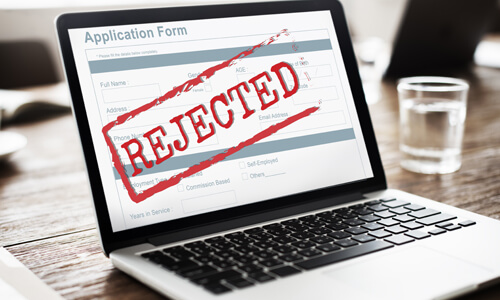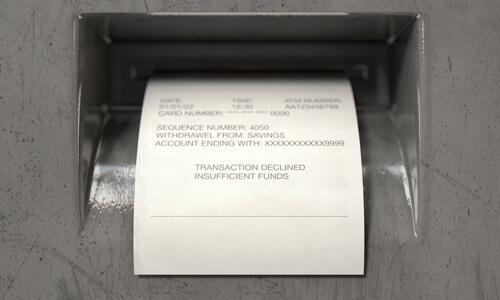An overdraft occurs when you do not have enough money in your checking account to cover a transaction, but your financial institution pays it anyway. Transactions like: bill payments, electronic transfers (ACH Debits), check transactions, and recurring check card transactions (e.g., gym membership), could all potentially overdraw your account if you have a low balance, but your financial institution (at its discretion) will authorize and pay them up to certain amount. Any and every time you overdraft, you are charged a fee.
In 2010, financial institutions made certain types of overdraft protection (for everyday ATM and debit card transactions) an opt-in service, giving consumers the power to decide if they want it. Overdraft protection can be a lifesaver when used responsibly. Below are some benefits and considerations before taking advantage of the service:
Benefits of Overdraft Protection:
- You are always ensured cash for emergencies, like a flat tire, or running out of gas.
- Without overdraft protection, your payment will rejected and you may also have to pay a nonsufficient funds fee (also called, NSF, bounced check, returned check or insufficient funds) fee to the retailer. (If the retailer tries to re-deposit your check, expect another fee).
- Bounced checks could end up hurting your ChexSystems report, and may even damage your credit.
Overdraft Protection Considerations:
- Multiple overdraft fees can add up quickly if you don’t realize you are overdrawn on your account. You will continue to get fee’d for every swipe that brings you negative, until you’ve hit the overdraft limit (typically, anywhere from $500 to $1000).
- Some people use overdraft protection to borrow money when they are short on cash, which was never the intention of the service. If used in this manner habitually, it can have a long-term negative impact on your finances.
What is the Difference Between an Overdraft Fee and an NSF Fee?
An overdraft (OD) fee is charged when your account goes negative and your overdraft protection kicks in to cover the transaction. The fee (sometimes called “Courtesy Fee” or “Courtesy Pay”) can be thought of as a fee for the courtesy of covering your transaction.
A nonsufficient funds (NSF) fee (also called insufficient funds, bounced check, payment rejected, or overdrawn account) is charged when your account is overdrawn and goes negative, and the item is returned.
A good way to think of it: financial institutions charge NSF fees when they return checks; financial institutions charge OD fees when they accept checks that overdraw checking accounts.
It’s important to note that financial institutions may only charge an overdraft or an NSF fee, never both for the same transaction.
How to Use Overdraft Protection Responsibly
Overdraft protection ensures you’re always covered, but it’s important to regularly monitor your account balance, so you are not needlessly hit with fees. Consider setting up account alerts or notifications in online banking, which allows you to create low-balance alerts when your account is in danger of being overdrawn.
There are other overdraft protection options many financial institutions will offer, that can kick in before the overdraft protection option described above, and save you some of the fees in the process:
- Many financial institutions offer Overdraft Lines of Credit, where you can keep a certain amount of money ready for transfer, should your balance fall short.
- Financial institutions will also allow you to link your checking account to your savings account. This allows you to borrow your own money instead of money from your financial institution. The charge for this will typically be less than a “Courtesy” overdraft protection program, or, a program in which the institution covers the charge.
If You Overdraft:
Be sure to deposit money into your account as soon as possible. The amount you deposit must be sufficient to cover the overdraft fees, plus any NSF fees incurred for a negative balance. By depositing enough money to bring your account positive, you should avoid any further fees from being assessed.
If you’re a good customer and this is your first offense, consider reaching out to your financial institution and explaining your situation. Just remember that in most cases, the fee is the penalty for overdrawing the account. The objective is not to overdraft and to try not to make a habit of it.
How to Find Out Your Levels of Overdraft Protection at Quorum*:
- Checking Reserve Line-of-Credit: Keeps $500 or more ready for transfer should your balance fall short of your needs. There is no cost, with no interest charged, until you use it. To apply:
- Log in to online banking.
- Under the “Open” tab, click on “Checking Reserve Line of Credit.”
- Click on “Continue” to start your application.
- Automatic Transfer: Is activated when your account is at risk of being overdrawn, automatically moving funds from your Basic Savings Account to your checking (fees apply for QClassic Checking). (Note: Should you wish to switch your Automatic Transfer from your Basic Savings Account to a different account, please contact Quorum at (800) 874-5544.)
- Extended Courtesy Pay: If opted in, we’ll automatically pay an overdraft for everyday ATM and debit card transactions:
- A fee of $37 applies for each overdraft. To opt in to Extended Courtesy Pay for your existing checking account:
- Log in to online banking.
- Select “Other Services” under the “More” tab.
- Click on “Opt In/Out of Courtesy Pay” under “Checking Account Services.”
- Complete and submit the form.
- A fee of $37 applies for each overdraft. To opt in to Extended Courtesy Pay for your existing checking account:
Note: Quorum’s Courtesy Pay will only activate after any an all applicable overdraft protection options (i.e., Checking Reserve Line-of-Credit and/or Overdraft Transfers from Savings) have been utilized.)
*Refer to the Truth-in-Savings disclosure for complete terms and conditions.






Comments Section
Please note: Comments are not monitored for member servicing inquiries and will not be published. If you have a question or comment about a Quorum product or account, please visit quorumfcu.org to submit a query with our Member Service Team. Thank you.